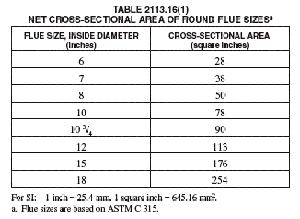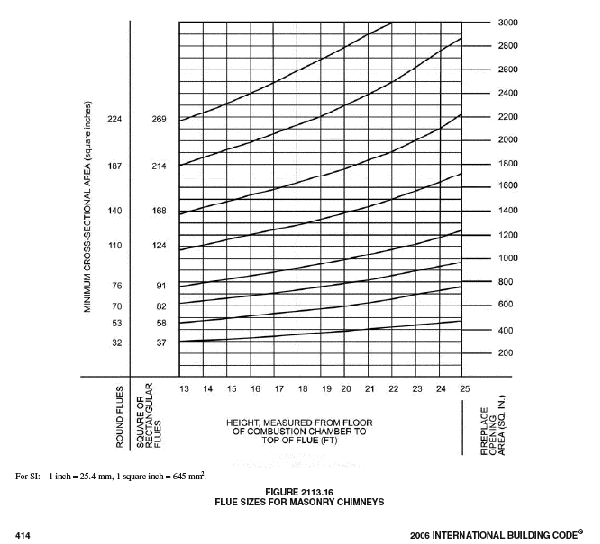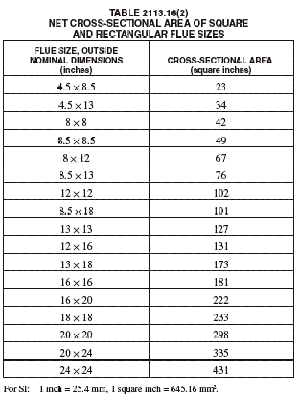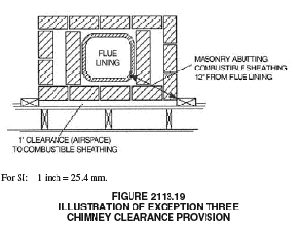|
MASONRY FIREPLACES
2111.2 Footings and foundations. Footings for masonry fireplaces and their chimneys shall be constructed of concrete or solid masonry at least 12 inches (305 mm) thick and shall extend at least 6 inches (153 mm) beyond the face of the fireplace or foundation wall on all sides. Footings shall be founded on natural undisturbed earth or engineered fill below frost depth. In areas not subjected to freezing, footings shall be at least 12 inches (305 mm) below finished grade.
|
2111.3.2 Horizontal reinforcing. Vertical reinforcement shall be placed enclosed within 1/4-inch (6.4 mm) ties or other reinforcing of equivalent net cross-sectional area, spaced not to exceed 18 inches (457mm) on center in concrete; or placed in the bed joints of unit masonry at a minimum of every 18 inches (457 mm) of vertical height. Two such ties shall be provided at each bend in the vertical bars.
|
|
2111.5 Firebox walls. Masonry fireboxes shall be constructed of solid masonry units, hollow masonry units grouted solid, stone or concrete. When alining of firebrick at least 2 inches (51 mm) in thickness or other approved lining is provided, the minimum thickness of back and sidewalls shall each be 8 inches (203 mm) of solid masonry, including the lining. The width of joints between firebricks shall not be greater than 1/4 inch (6.4 mm). When no lining is provided, the total minimum thickness of back and side walls shall be 10 inches (254 mm) of solid masonry. Firebrick shall conform to ASTM C27 or ASTM C1261 and shall be laid with medium-duty refractory mortar conforming to ASTM C 199.
|
2111.8 Smoke chamber walls. Smoke chamber walls shall be constructed of solid masonry units, hollow masonry units grouted solid, stone or concrete. Corbelling of masonry units shall not leave unit cores exposed to the inside of the smoke chamber. The inside surface of corbelled masonry shall be parged smooth. Where no lining is provided, the total minimum thickness of front, back and side walls shall be 8 inches (203 mm) of solid masonry. When a lining of firebrick at least 2 inches (51 mm) thick, or a lining of vitrified clay at least 5/8 inch (15.9 mm) thick, is provided, the total minimum thickness of front, back and side walls shall be 6 inches (152 mm) of solid masonry, including the lining. Firebrick shall conform to ASTMC 27 or C 1261 and shall be laid with medium-duty refractory mortar conforming to ASTM C 199.
2111.9.2 Hearth extension thickness. The minimum thickness of hearth extensions shall be 2 inches (51 mm). Exception: When the bottom of the firebox opening is raised at least 8 inches (203 mm) above the top of the hearth extension, a hearth extension of not less than 3/8 -inch-thick (9.5 mm) brick, concrete, stone, tile or other approved noncombustible material is permitted.
|
2111.11 Fireplace clearance. Any portion of a masonry fireplace located in the interior of a building or within the esterior walls of a building shall have a clearance to combustibles of not
less than 2 inches (51 mm) from the front faces and sides of masonry fireplaces and not less than 4 inches (102 mm) from the back faces of masonry fireplaces. The air space shall not be filled, except to provide fire blocking in accordance with Section R1003.13.
1. Masonry fireplaces listed and labeled for use in contact with combustibles in accordance with UL127 and installed in accordance with the manufacturer's installation instructions are permitted to have combustible material in contact with their exterior surfaces. 2. When masonry fireplaces are part of masonry or concrete walls, combustible materials shall not be in contact with the masonry or concrete walls less than 12 inches (305 mm)from the inside surface of the nearest firebox lining.
|
3. Exposed combustible trim and the edges of sheathing materials, such as wood siding, flooring and drywall, are permitted to abut the masonry fireplace side walls and hearth extension in accordance with Figure 2111.11, provided such combustible trim or sheathing is a minimum of 12 inches (305 mm) from the inside surface of the nearest firebox lining. 4. Exposed combustible mantels or trim is permitted to be placed directly on the masonry fireplace front surrounding the fireplace opening, providing such combustible materials shall not be placed within 6 inches (152 mm) of a fireplace opening. Combustible material directly above and within 12 inches (306 mm) of the fireplace opening shall not project more than 1/8 inch (3.2 mm) for each 1-inch (25.4 mm) distance from such an opening. Combustible materials located along the sides of the fireplace opening that project more than 1-1/2 inches (38 mm) from the face of the fireplace shall have an additional cleanance equal to the projection. |
|
2111.12 Fireplace fireblocking. All spaces between fireplace and floors and ceilings through which fireplaces pass shall be fireblocked with noncombustible material securely fastened in place. the fireblocking of spaces between wood joists, beems or headers shall be to a depth of 1 inch (25 mm) and shall only be placed on strips of metal or metal lath laid across the spaces betweent combustible material and the chimney. 2111.13 Exterior air. Factory-built or masonry fireplaces covered in this chapter shall be equipped with an exterior air supply to assure proper fuel combustion unless the room is mechanically ventilated and controlled so that the indoor pressure is neutral or positive.
2111.13.2 Masonry fireplaces. Listed combustion air ducts for masonry fireplaces shall be installed according to the terms of their listing and manufacturer’s instructions.
|
2111.13.3 Exterior air intake. The exterior air intake shall be
capable of providing all combustion air from the exterior of the
dwelling. The exterior air intake shall not be located within the
garage, attic, basement or crawl space of the dwelling nor shall the air intake be
located at an elevation higher than the firebox. The exterior air
intake shall be covered with a corrosion-resistant screen of
1/4 -inch (6.4 mm) mesh. 2111.13.4 Clearance. Unlisted combustion air ducts shall be installed with a minimum 1-inch (25.4 mm) clearance to combustibles for all parts of the duct within 5 feet (1524 mm) of the duct outlet. 2111.13.5 Passageway. The combustion air passageway shall be a minimum of 6 square inches (3870 mm2) and not more than 55 square inches (0.035 m2), except that combustion air systems for listed fireplaces shall be constructed according to the fireplace manufacturer's instructions. 2111.13.6 Outlet. The exterior air outlet is permitted to be located in the back or sides of the firebox chamber or within 24 inches (610 mm) of the firebox opening on or near the floor. The outlet shall be closable and designed to prevent burning material from dropping into concealed combustible spaces.
|
|
MASONRY HEATERS
2112.2 Installation. Masonry heaters shall be installed in accordance with this section and comply with one of the following:
2. Masonry heaters shall be listed and labeled in accordance with UL 1482 and installed in accordance with the manufacturer's installation instructions.
|
2112.4 Seismic reinforcing. In Seismic Design Category D, E and F, masonry heaters shall be anchored to the masonryt foundation in accordance with Section 2113.3. Seismic reinforcing shall not be required within the body of a masonry heater with a height that is equal to or less than 3.5 times its body width and where the masonry chimney serving the heater is not supported by the body of the heater. Where the masonry chimney shares a common wall with the facing of the masonry heater, the chimney portion of the structure shall be reinforced in accordance with Sections 2113. 2112.5 Masonry heater clearance. Combustible materials shall not be placed within 36 inches (765 mm) of the outside surface of a masonry heater in accordance with NFPA 211, Section 8-7 (clearances for solid fuel-burning appliances), and the required space betweent he heater and combustible material shall be fully vented to permit the free flow of air around all heater surfaces.
1. When a masonry heater wall is at least 8 inches (203 mm) thick of solid masonry and the wall thickness of the heat exchange channels is at least 5 inches (127 mm) thick of solid masonry, combustible materials shall not be placed within 4 inches (102 mm) of the outside surface of a masonry heater. A clearance of at least 8 inches (203 mm) shall be provided between the gas-tight capping slab of the heater and a combustible ceiling. 2. Masonry heaters listed and labeled in accordance with UL 1482 and installed in accordnacve with the manufacturer's instructions.
|
|
MASONRY CHIMNEYS
2113.2 Footings and foundations. Foundationsformasonry chimneys shall be constructed of concrete or solid masonry at least 12 inches (305 mm) thick and shall extend at least 6 inches (152 mm) beyond the face of the foundation or support wall on all sides. Footings shall be founded on natural undisturbed earth or engineered fill below frost depth. In areas not subjected to freezing, footings shall be at least 12 inches (305 mm) below finished grade. 2113.3 Seismic reinforcing. Masonry or concrete chimneys shall be constructed, anchored, supported and reinforced as required in this chapter. In Seismic Design Category D, masonry and concrete chimneys shall be reinforced and anchored as detailed in Sections 2113.3.1, 2113.3.2 and 2113.4. In Seismic Design Category A, B or C, reinforcement and seismic anchorage is not required. In Seismic Design Category Eor F, masonry and concrete chimneys shall be reinforced in accordance with the requirements of Sections 2101 through 2108.
2113.3.2 Horizontal reinforcing. Vertical reinforcement shall be placed enclosed within 1/4-inch (6.4 mm) ties, or other reinforcing of equivalent net cross-sectional area, spaced not to exceed 18 inches (457 mm) o.c. in concrete, or placed in the bed joints of unit masonry, at a minimum of every 18 inches (457 mm) of vertical height. Two such ties shall be provided at each bend in the vertical bars.
2113.6 Changes in dimension. The chimney wall or chimney flue lining shall not change in size or shape within 6 inches (152 mm) above or below where the chimney passes through floor components, ceiling components or roof components. 2113.7 Offsets. Where a masonry chimney is constructed with a fireclay flue liner surrounded by one wythe of masonry, the maximum offset shall be such that the centerline of the flue above the offset does not extend beyond the center of the chimney wall below the offset. Where the chimney offset is supported by masonry below the offset in an approved manner, the maximum offset limitations shall not apply. Each individual corbeled masonry course of the offset shall not exceed the projection limitations specified in Section 2113.5. 2113.8 Additional load. Chimneys shall not support loads other than their own weight unless they are designed and constructed to support the additional load. Masonry chimneys are permitted to be constructed as part of the masonrywalls or concrete walls of the building.
|
2113.9 Termination. Chimneys shall extend at least 2 feet
(610 mm) higher than any portion of the building within 10 feet
(3048 mm), but shall not be less than 3 feet (914 mm) above the
highest point where the chimney passes through the roof.
1. The net free area of the arrestor shall not be less than four times the net free area of the outlet of the chimney flue it serves. 2. The arrestor screen shall have heat and corrosion resistance equivalent to 19-gage galvanized steel or 24-gage stainless steel. 3. Openings shall not permit the passage of spheres having a diameter greater than 1/2 inch (13 mm) nor block the passage of spheres having a diameter less than 3/8 inch (11 mm). 4. The spark arrestor shall be accessible for cleaning and the screen or chimney cap shall be removable to allow for cleaning of the chimney flue.
2. Listed chimney lining systems complying with UL 1777. 3. Factory-built chimneys or chimney units listed for installation within masonry chimneys. 4. Other approved materials that will resist corrosion, erosion, softening or cracking from flue gases and condensate at temperatures up to 1,800¡F (982¡C).
2113.11.1.2 Gas appliances. Flue lining systems for gas appliances shall be in accordance with the International Fuel Gas Code. 2113.11.1.3 Pellet fuel-burning appliances. Flue lining and vent systems for use in masonry chimneys with pellet fuel-burning appliances shall be limited to flue lining systems complying with Section 2113.11.1 and pellet vents listed for installation within masonry chimneys (see Section 2113.11.1.5 for marking). 2113.11.1.4 Oil-fired appliances approved for use with L-vent. Flue lining and vent systems for use in masonry chimneys with oil-fired appliances approved for use with Type L vent shall be limited to flue lining systems complying with Section 2113.11.1 and listed chimney liners complying with UL 641 (see Section 2113.11.1.5 for marking). 2113.11.1.5 Notice of usage. When a flue is relined with a material not complying with Section 2113.11.1, the chimney shall be plainly and permanently identified by a label attached to a wall, ceiling or other conspicuous location adjacent to where the connector enters the chimney. The label shall include the following message or equivalent language: ÒThis chimney is for use only with (type or category of appliance) that burns (type of fuel). Do not connect other types of appliances.Ó
|
|
2113.11.2 Concrete and masonry chimneys for
medium-heat appliances.
2113.11.2.2 Construction. Chimneys for medium-heat appliances shall be constructed of solid masonry units or of concrete with walls a minimum of 8 inches (203 mm) thick, or with stone masonry a minimum of 12 inches (305 mm) thick. 2113.11.2.3 Lining. Concrete and masonry chimneys shall be lined with an approved medium-duty refractory brick a minimum of 41/2 inches (114 mm) thick laid on the 41/2-inch bed (114 mm) in an approved medium-duty refractory mortar. The lining shall start 2 feet (610 mm) or more below the lowest chimney connector entrance. Chimneys terminating 25 feet (7620 mm) or less above a chimney connector entrance shall be lined to the top. 2113.11.2.4 Multiple passageway. Concrete and masonry chimneys containing more than one passageway shall have the liners separated by a minimum 4-inch-thick (102 mm) concrete or solid masonry wall. 2113.11.2.5 Termination height. Concrete and masonry chimneys for medium-heat appliances shall extend a minimum of 10 feet (3048 mm) higher than any portion of any building within 25 feet (7620 mm). 2113.11.2.6 Clearance. A minimum clearance of 4 inches (102 mm) shall be provided between the exterior surfaces of a concrete or masonry chimney for medium-heat appliances and combustible material.
2113.11.3.2 Construction. Chimneys for high-heat appliances shall be constructed with double walls of solid masonry units or of concrete, each wall to be a minimum of 8 inches (203 mm) thick with a minimum airspace of 2 inches (51 mm) between the walls. 2113.11.3.3 Lining. The inside of the interior wall shall be lined with an approved high-duty refractory brick, a minimum of 41/2 inches (114 mm) thick laid on the 41/2-inch bed (114 mm) in an approved high-duty refractory mortar. The lining shall start at the base of the chimney and extend continuously to the top. 2113.11.3.4 Termination height. Concrete and masonry chimneys for high-heat appliances shall extend a minimum of 20 feet (6096 mm) higher than any portion of any building within 50 feet (15 240 mm). 2113.11.3.5 Clearance. Concrete and masonry chimneys for high-heat appliances shall have approved clearance from buildings and structures to prevent overheating combustible materials, permit inspection and maintenance operations on the chimney and prevent danger of burns to persons.
|
2113.12 Clay flue lining (installation). Clay flue liners shall
be installed in accordance withASTMC 1283 and extend from
a point not less than 8 inches (203 mm) below the lowest inlet
or, in the case of fireplaces, from the top of the smoke chamber
to a point above the enclosing walls. The lining shall be carried
up vertically, with a maximum slope no greater than 30 degrees
(0.52 rad) from the vertical. Clay flue liners shall be laid in medium-duty refractory mortar conforming to ASTM C 199 with tight mortar joints left smooth on the inside and installed to maintain an air space or insulation not to exceed the thickness of the flue liner separating the flue liners from the interior face of the chimney masonrywalls. Flue lining shall be supported on all sides. Only enough mortar shall be placed to make the joint and hold the liners in position. 2113.13 Additional requirements.
2113.13.2 Space around lining. The space surrounding a chimney lining system or vent installed within a masonry chimney shall not be used to vent any other appliance.
2. Chimney flues serving gas-fired appliances sized in accordance with the International Fuel Gas Code.
|
|

|

 2113.17 Inlet. Inlets to masonry chimneys shall enter from the side. Inlets shall have a thimble of fireclay, rigid refractory material or metal that will prevent the connector from pulling out of the inlet or from extending beyond thewall of the liner. 2113.18 Masonry chimney cleanout openings. Cleanout openings shall be provided within 6 inches (152 mm) of the base of each flue within every masonry chimney. The upper edge of the cleanout shall be located at least 6 inches (152 mm) below the lowest chimney inlet opening. The height of the opening shall be at least 6 inches (152 mm). The cleanout shall be provided with a noncombustible cover.
|
2. Where masonry chimneys are constructed as part of masonry or concrete walls, combustible materials shall not be in contact with the masonry or concrete wall less than 12 inches (305 mm) from the inside surface of the nearest flue lining. 3. Exposed combustible trim and the edges of sheathing materials, such as wood siding, are permitted to abut the masonry chimney sidewalls, in accordance with Figure 2113.19, provided such combustible trim or sheathing is a minimum of 12 inches (305 mm) from the inside surface of the nearest flue lining. Combustible material and trim shall not overlap the corners of the chimney by more than 1 inch (25 mm).
 2113.20 Chimney fireblocking. All spaces between chimneys and floors and ceilings through which chimneys pass fireblocked with noncombustible material securely fastened place. The fireblocking of spaces between wood joists, or headers shall be to a depth of 1 inch (25 mm) and shall be placed on strips of metal or metal lath laid across the between combustible material and the chimney.
|

Back to Codes and Standards
Buckley Rumford Fireplaces
Copyright 1996 - 2006 Jim Buckley
All rights reserved.
webmaster